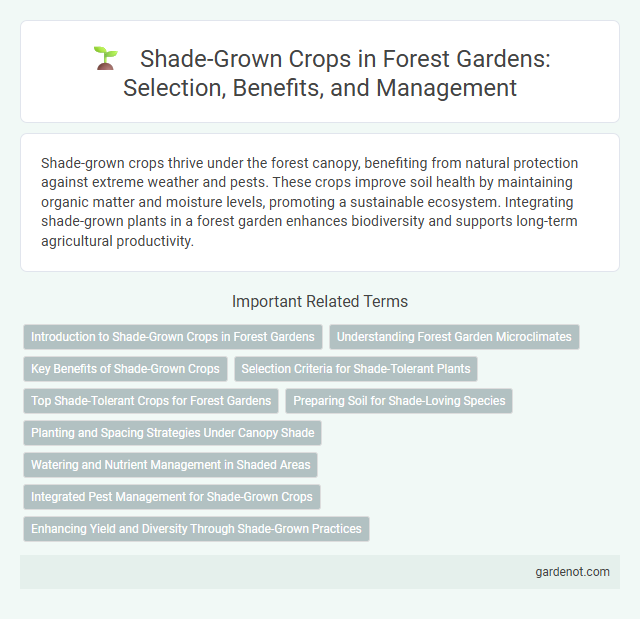Shade-grown crops thrive under the forest canopy, benefiting from natural protection against extreme weather and pests. These crops improve soil health by maintaining organic matter and moisture levels, promoting a sustainable ecosystem. Integrating shade-grown plants in a forest garden enhances biodiversity and supports long-term agricultural productivity.
Introduction to Shade-Grown Crops in Forest Gardens
Shade-grown crops in forest gardens thrive under the protective canopy of trees, optimizing natural sunlight and promoting biodiversity. These crops, including coffee, cacao, and certain medicinal plants, benefit from reduced temperature extremes and enhanced soil moisture retention. Integrating shade-grown crops supports sustainable agroforestry practices, improves ecosystem health, and increases long-term agricultural resilience.
Understanding Forest Garden Microclimates
Shade-grown crops thrive in forest garden microclimates by benefiting from the filtered sunlight and moderated temperatures provided by the canopy layers. These microclimates reduce water evaporation and protect plants from extreme weather, enhancing crop resilience and yield. Understanding the interaction between shade levels, humidity, and soil moisture in forest gardens is essential for optimizing shade-grown crop production.
Key Benefits of Shade-Grown Crops
Shade-grown crops enhance biodiversity by creating habitats for pollinators and natural pest predators, leading to reduced pesticide use. These crops improve soil health through increased organic matter and moisture retention, promoting sustainable forest garden ecosystems. Furthermore, shade-grown cultivation supports higher nutritional value and better flavor in produce by maintaining cooler growing conditions.
Selection Criteria for Shade-Tolerant Plants
Shade-tolerant plants selected for forest gardens must exhibit robust photosynthetic efficiency under low light conditions and possess adaptive leaf morphologies to maximize light capture. Key criteria include drought resistance, slow growth rates that prevent canopy overshadowing, and compatibility with surrounding species to maintain ecosystem balance. Emphasis on nutrient acquisition strategies and pest resilience further ensures the sustainability of shade-grown crops within multi-layered agroforestry systems.
Top Shade-Tolerant Crops for Forest Gardens
Top shade-tolerant crops for forest gardens include cocoa, coffee, and cardamom, which thrive under dense tree canopies while enhancing biodiversity. Other highly shade-adapted plants like wild ginger, turmeric, and leafy greens such as spinach and chard also contribute to soil health and layered productivity. Integrating these crops optimizes forest garden yields by maximizing vertical space and promoting ecological balance.
Preparing Soil for Shade-Loving Species
Preparing soil for shade-loving species in a forest garden involves enriching the soil with organic matter such as compost or leaf mold to improve moisture retention and nutrient availability under low-light conditions. Incorporating mulch layers helps maintain stable soil temperatures and protects roots from drying out in shaded environments. Selecting soil with good drainage and structure ensures optimal growth for shade-grown crops like tea, coffee, or certain medicinal herbs commonly cultivated in agroforestry systems.
Planting and Spacing Strategies Under Canopy Shade
Planting shade-tolerant crops such as coffee, cacao, and certain spices beneath a forest garden canopy requires careful spacing to balance light availability and root competition. Optimal spacing involves positioning plants to maximize dappled sunlight exposure while maintaining sufficient airflow to reduce disease risks. Adopting staggered or clustered planting patterns helps create microclimates that enhance growth under variable light conditions within dense canopy shade.
Watering and Nutrient Management in Shaded Areas
Shade-grown crops in forest gardens require careful watering strategies to accommodate reduced sunlight and slower soil drying rates, emphasizing consistent moisture retention without overwatering. Nutrient management focuses on enhancing soil fertility through organic mulches and nitrogen-fixing plants, promoting balanced nutrient availability under shaded conditions. Implementing drip irrigation systems and incorporating composted leaf litter supports sustainable growth and optimal crop yield in shaded forest garden environments.
Integrated Pest Management for Shade-Grown Crops
Shade-grown crops in forest gardens benefit from integrated pest management (IPM) strategies that emphasize natural predator habitats, crop diversity, and minimal chemical interventions. Implementing IPM techniques such as intercropping with pest-repellent plants and encouraging beneficial insects enhances crop resilience and reduces pest outbreaks. Maintaining a balanced ecosystem through these practices promotes sustainable pest control and healthier shade-grown crop yields.
Enhancing Yield and Diversity Through Shade-Grown Practices
Shade-grown crops in forest gardens leverage the natural canopy to create a microclimate that enhances moisture retention and reduces soil erosion, significantly boosting overall yield. These practices promote biodiversity by supporting diverse plant species and beneficial insects, contributing to ecosystem resilience. Integrating shade-grown techniques optimizes resource use and sustains productive harvests while preserving forest structure.
Shade-grown crop Infographic

 gardenot.com
gardenot.com